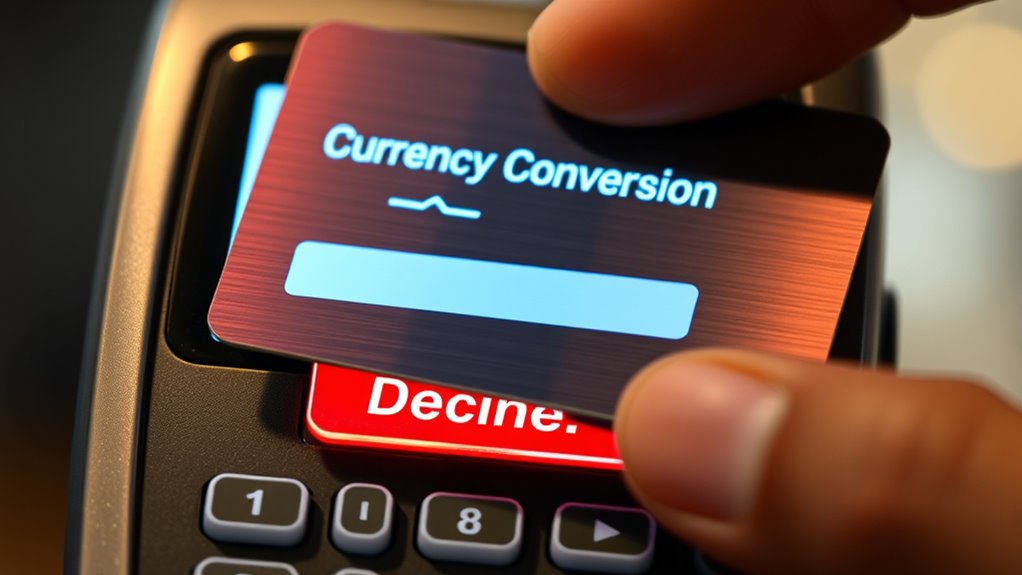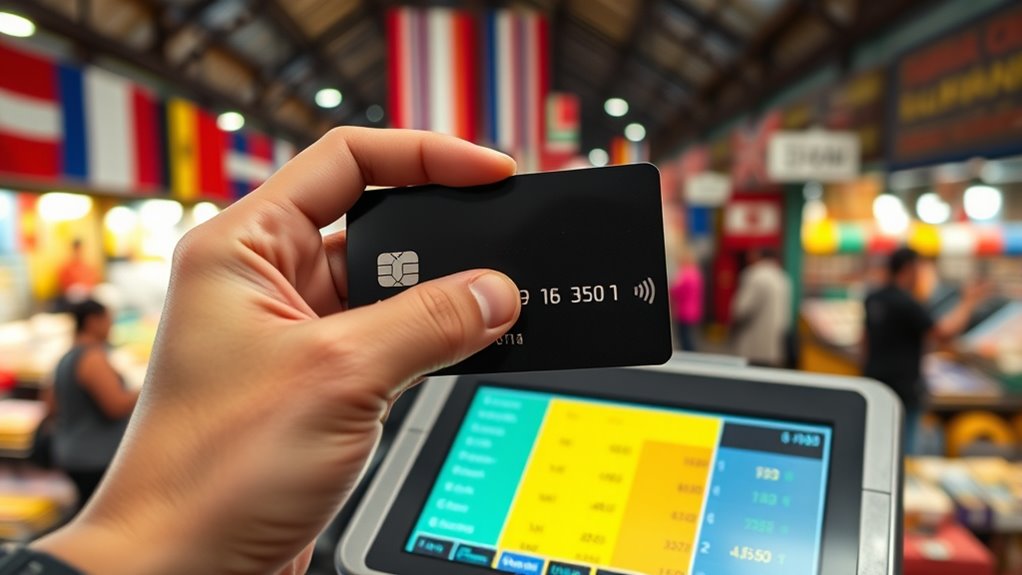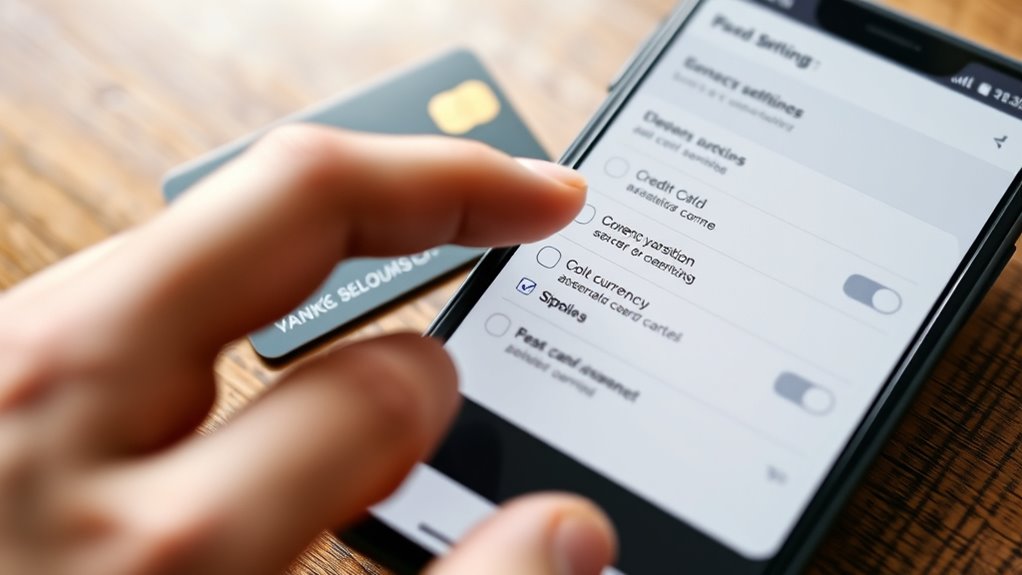To avoid dynamic currency conversion fees, look out for DCC prompts during transactions and decline them when offered, choosing to pay in the local currency instead. Use credit cards with no foreign transaction fees, which help you save on extra charges and get better exchange rates. Manage your payment settings so automatic conversions are disabled, and always verify you’re paying in the local currency. If you’re curious about more tips, there’s more to explore.
Key Takeaways
- Decline DCC offers at checkout by choosing to pay in the local currency.
- Use credit cards with no foreign transaction fees and select local currency payments.
- Review and disable automatic currency conversion in your bank or card settings.
- Understand exchange rates and time your purchases for favorable rates.
- Monitor your transactions regularly to ensure charges are transparent and avoid hidden DCC fees.
Recognize the Offer of DCC at the Point of Sale

When you make a purchase abroad, the merchant may offer you the option of Dynamic Currency Conversion (DCC). This usually appears as a prompt on the card reader or at checkout, asking if you’d like to pay in your home currency instead of the local currency. It might sound convenient, but don’t be fooled. The offer is often presented as an easy way to see the amount in your currency, but it typically comes with higher fees and less favorable exchange rates. Always stay alert for this prompt, and remember that you have the right to decline. Recognizing this offer early helps you avoid agreeing to DCC unintentionally, saving you money and keeping your transaction transparent. Be aware that third-party cookies are often used to track user preferences and may be involved in DCC promotions, so managing your cookie settings can help protect your privacy. Additionally, understanding exchange rates can help you better evaluate the true cost of your transaction. Using consumer awareness techniques can also enhance your decision-making skills, especially when navigating complex financial choices like DCC. Being aware of transaction fees and how they impact the total cost can further empower you to make informed choices at the point of sale.
Decline the Currency Conversion Option

To avoid unnecessary fees, always choose the local currency when paying. Check your payment settings beforehand to make certain you’re not automatically opting into currency conversion. During checkout, opt out of the conversion offer if given the choice to keep the transaction in your home currency.
Select Local Currency Only
Choosing to decline the currency conversion option at checkout is one of the simplest ways to avoid extra fees. When you see the option to pay in your home currency, select it instead of the local currency. This prevents the merchant or payment processor from converting the amount on your behalf, which often involves additional charges. By choosing your native currency, your bank processes the payment directly in your account’s currency, often resulting in better exchange rates and fewer fees. Additionally, understanding SWIFT/BIC codes can help ensure your transaction is routed correctly and securely. Being aware of dynamic currency conversion practices can further protect you from hidden costs. Always look for a prompt or checkbox that says “Pay in [your currency]” or “Use your home currency.” This simple step ensures you’re in control of the currency used and helps you avoid unnecessary charges associated with dynamic currency conversion.
Check Payment Settings
Checking your payment settings before completing a transaction can help you avoid unwanted currency conversion fees. Many payment platforms allow you to control whether they convert currency for you or let you pay in the local currency. Look for an option to decline currency conversion or choose “pay in local currency.” This setting ensures your card issuer handles the currency exchange, often resulting in better rates and fewer fees. Review your account or payment app’s preferences and disable any automatic conversion features. Being aware of dynamic currency conversion options can prevent surprise charges and help you manage your expenses more effectively. Additionally, understanding the industry trends related to currency exchange can inform you about better alternatives. Familiarizing yourself with the security measures used by payment platforms can also protect you from potential fraud during transactions. Implementing risk management strategies can further safeguard your transactions from vulnerabilities. Staying informed about cookie categories can help you recognize how your data is used during transactions. By taking a moment to verify these settings, you prevent the merchant or payment processor from applying dynamic currency conversion. This simple step puts you in control of your transaction, saving you money and avoiding surprise charges.
Opt Out During Checkout
During checkout, you have the opportunity to decline dynamic currency conversion offers. When prompted to choose a currency, look for an option that says something like “Pay in your home currency” or “Decline currency conversion.” Selecting this option guarantees your card issuer processes the transaction in your native currency, avoiding unnecessary fees. Don’t just accept the default, as it might be offering DCC without explaining the costs. Take a moment to review the options carefully. If you see a checkbox or button to decline the conversion, click it. This simple step helps you avoid extra charges and keeps the total amount transparent. Always double-check before confirming your payment to ensure you’ve opted out of dynamic currency conversion. Understanding DCC can help you make more informed decisions during checkout. Being aware of Bitcoin IRA concepts, such as managing market volatility, can also influence how you handle financial transactions involving international purchases. Additionally, recognizing the world of online payments can help you identify safer and more cost-effective options. Familiarizing yourself with privacy policies ensures your data remains protected while navigating these choices, especially when using digital wallets for international transactions.
Use Credit Cards With No Foreign Transaction Fees

Using credit cards that have no foreign transaction fees can save you a significant amount of money while traveling abroad. These cards don’t charge extra for purchases made outside your home country, helping you avoid unnecessary costs. Look for cards specifically designed for international travel, often advertised as “no foreign transaction fee” cards. They typically offer competitive exchange rates, which means you’re not losing money through poor currency conversions. Keep in mind, some cards may still have other fees, so always review the terms. Using such a card simplifies transactions, reduces the need for currency exchanges, and minimizes the risk of being hit with DCC fees. This way, you can focus on your trip without worrying about hidden costs eating into your budget.
Opt for Local Currency Payments When Possible

Whenever you have the option, paying in the local currency is one of the best ways to avoid dynamic currency conversion fees. When you choose to pay in the local currency, your bank or card issuer manages the currency exchange, often at a better rate than the merchant’s DCC service. This means you avoid extra markups and hidden fees that come with DCC. Always look for the currency option on payment terminals or online checkouts and select the local currency instead of your home currency. This simple step guarantees transparency and helps you save money. Remember, if you’re unsure, ask the merchant if you can pay in the local currency to make sure you’re avoiding unnecessary charges. Being aware of your currency conversion options can further help you make informed payment decisions. Additionally, understanding how transaction fees are applied can prevent unexpected expenses. Being familiar with exchange rates can also help you determine the best time to make purchases to maximize savings. Knowing about currency exchange rates can help you plan your spending for better financial outcomes. For example, understanding foreign exchange fluctuations can allow you to time your payments more effectively.
Keep Track of Your Card’s Settings and Preferences

To avoid unexpected currency conversion fees, it’s essential to regularly review and adjust your card’s settings and preferences. Check your account online or through your bank’s app to see if there’s an option to disable Dynamic Currency Conversion or specify your preferred currency. Some cards automatically convert to your home currency, while others allow you to choose your preferred currency at the point of sale. Adjust these settings to ensure transactions are processed in local currency, avoiding unnecessary fees. Also, verify if your card provider has specific international use preferences or alerts. Staying proactive helps you maintain control over how your transactions are processed, reducing surprises and saving money during your travels. Regularly updating these preferences keeps you informed and minimizes potential charges.
Stay Informed About Your Card’s International Use Policies

Staying informed about your card’s international use policies is essential for avoiding unexpected fees. Check your bank’s website or contact customer service to understand any restrictions, fees, or conditions for overseas transactions. Some cards automatically enable international use, while others require you to notify your bank beforehand to prevent declines or holds. Be aware of policies related to currency conversions, especially if your card charges foreign transaction fees. Also, review whether your card supports contactless payments abroad or has limitations in certain countries. By understanding these policies, you can plan your transactions accordingly, avoid surprises, and select the best payment methods. Staying proactive ensures you won’t be caught off guard by fees or restrictions, saving you money and hassle during your travels.
Frequently Asked Questions
Can DCC Fees Vary Between Merchants or Countries?
Yes, DCC fees can differ between merchants and countries. When you make a purchase, some merchants may include higher fees or markups, especially in countries with different currencies. These fees depend on the merchant’s policies and the local regulations. To avoid surprises, always check the currency options before completing your transaction and opt for transactions in your home currency if possible, as this can help you save money.
Are There Specific Credit Cards Recommended to Avoid DCC Fees?
You should choose credit cards that don’t charge foreign transaction fees, as they often waive DCC charges. Look for cards specifically designed for travelers, which usually offer no foreign exchange fees or DCC fees. Major banks and travel-focused issuers often provide these options. Using such a card guarantees you pay the local currency amount, avoiding extra charges and saving money on international purchases.
How Does Dynamic Currency Conversion Impact Exchange Rates?
Did you know that DCC can add up to 10% extra on your purchase? When you use DCC, you see the transaction in your home currency, but the exchange rate often isn’t favorable. This means you might pay more than the actual market rate. So, it impacts your costs by making your purchases more expensive, and you lose transparency on the true exchange rate, often paying a hidden fee.
Are Mobile Payment Apps Also Susceptible to DCC Charges?
Mobile payment apps can indeed be susceptible to DCC charges. When you use such apps abroad, they often offer the option to pay in your home currency, which triggers DCC. If you choose that, you might face higher exchange rates and additional fees. To avoid this, always select to pay in the local currency, as this helps you sidestep unnecessary DCC fees and get better exchange rates.
What Are the Long-Term Effects of Frequent DCC Usage on Credit Scores?
Like a pebble creating ripples, frequent DCC usage can subtly impact your credit score over time. It may cause increased credit utilization or prompt more inquiries, which lenders see as risk factors. If you don’t manage these transactions carefully, you might notice your score dipping. Stay vigilant, keep track of your spending, and pay bills on time to guarantee DCC doesn’t quietly undermine your financial health.
Conclusion
So, next time you’re abroad, remember to decline that tempting DCC offer—because, after all, who wouldn’t want to pay extra just for the privilege? Keeping your cards’ settings in check might seem tedious, but it’s a small price to pay for avoiding unnecessary fees. Ironically, the hassle of staying informed can save you a fortune; sometimes, the simplest choice is to stick with the local currency and enjoy your trip without the extra charge.









